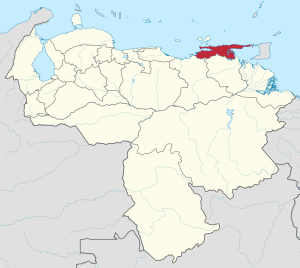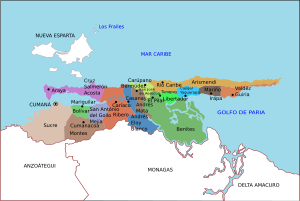Lake Bermudez facts for kids
Lake Guanoco (also called Lago Guanoco or Lago de Asfalto de Guanoco in Spanish) is a huge natural tar pit. It's also known as Lake Bermudez. This amazing lake is found in Venezuela, a country in northern South America.
Lake Guanoco is the second largest natural tar pit in the world. It is one of only five natural asphalt lakes on Earth. The other four are Pitch Lake in Trinidad and Tobago, and three in the US state of California: La Brea Tar Pits in Los Angeles, McKittrick Tar Pits in McKittrick, and Carpinteria Tar Pits in Carpinteria.
Where is Lake Guanoco Located?
Lake Guanoco is in the state of Estado Sucre in Venezuela. It's about 140 km (87 mi) southeast of a city called Cumaná. The lake is very close to a place called Libertador. It's also only about 25 km (16 mi) east of the Golfo de Paria, which is a large gulf.
The surface of this asphalt lake covers about 445 ha (1,100 acres). Its depth changes, usually between 1.5 to 2 m (4.9 to 6.6 ft). Even though Lake Guanoco covers a larger area than Pitch Lake in Trinidad, it has less tar overall. However, the tar in Lake Guanoco is purer. What makes Lake Guanoco special is that it's covered in plants and trees, unlike other asphalt lakes.
How Do Asphalt Lakes Form?
Scientists believe that all asphalt lakes formed a very long time ago, during the Pleistocene epoch. They all form in a similar way.
Asphalt lakes are the biggest examples of natural oil seeps. This happens when oil, which is lighter than water, moves up through the ground. Instead of getting stuck underground, the oil reaches the surface. When the oil gets to the surface, it turns into thick asphalt or tar. This change happens because of tiny living things called bacteria. These bacteria eat parts of the oil. This process, called biodegradation, happens close to the surface where it's cool enough for the bacteria to live.
History of Lake Guanoco
No one knows exactly when Lake Guanoco was first discovered. However, the Warao people, who are native to the area, knew about it for a very long time. They used the natural asphalt to make their canoes waterproof.
In 1799, a German explorer named Alexander von Humboldt visited the site. During his trip to Latin America, he described it as "The spring of the good priest."
In 1883, the Venezuelan government made a deal with two Americans, Horacio R. Hamilton and Jorge A. Phillips. They were given permission to mine the asphalt for 25 years. This deal caused some arguments because the profits went to foreign companies.
Mining started in 1890 by the New York & Bermúdez Company. This company was part of a larger company called General Asphalt from New York. In 1899, the Venezuelan government, led by Cipriano Castro, asked the company to pay higher taxes. In response, the company supported a political opponent named Manuel Antonio Matos. This disagreement grew into a big conflict between 1902 and 1903. It was even called the "Asphalt War." The conflict became so serious that the US and Venezuela stopped talking to each other for a while in 1908. This happened after President Castro took control of the company's property.
Commercial mining of the asphalt stopped in 1934. It has not started again since then.
See also
 In Spanish: Lago de asfalto de Guanoco para niños
In Spanish: Lago de asfalto de Guanoco para niños




